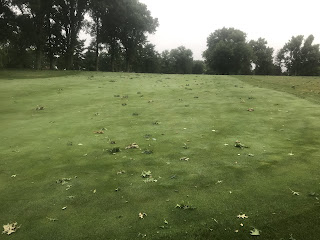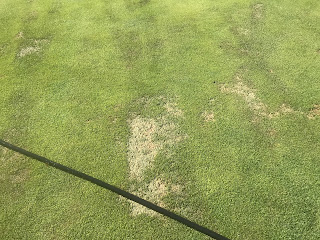There is only one four letter word that is banned on the Grounds Department. It causes more work for us than most all other weather phenomena combined and is only rivaled by the once in a decade ice storm. Like the word "Beetlejuice" I hate to even mention it, for if said enough it may appear to wreak havoc on the course again! It is Wind!
Two recent wind storms in particular caused a tremendous amount of debris. One on June 21st and another on July 6th. There have been some questions as to why we must shut down the golf course after storms that produce minimal precipitation. The answer is, the number of small limbs, leaves, large branches, and garbage that these windstorms produce causes, in most cases, a whole day's work or more to clean up. During the June 21st storm a pin oak with a tight bifurcation (double trunk tree) split at the branch intersection and took a whole day to cut up and remove. Small branches, from ovipositor cicada damage, fall with regularity and with a strong wind are intensified. Leaves and twigs must be blown off high trafficked areas (greens, tees, fairways) and either chopped up or picked up. Chain saws must be used for bigger limbs with firewood stacked and small debris taken to the dump areas. Of course, all of this work replaces the daily maintenance schedule and pushes us behind on much needed mowing, watering, rolling, and spraying. Please understand that areas have to be cleaned up before daily grooming can occur to get the golf course into playable conditions that meet expectations.
 |
| Debris from the July 6th thunderstorm |
 |
| Right of #10 cart path |
 |
| #13 fairway |
 |
| #8 fairway |
 |
| #18 green |
 |
| Garbage and debris next to #13 cart path |
 |
| White pine limbs down on #15 |
 |
| #7 fairway |
 |
#15
|
 |
| Honey locust limbs by #18 cart path |
 |
| Pin oak with bifurcation trunks split during the June 21st storm. This tree will need to be removed soon. |
 |
| Co-dominant leader that split. This picture doesn't do the size justice. It took almost a whole day to cut up. |
Close to the wettest May on record followed by a dry June has stressed out some of the turf on the golf course. In May, the heavy amount of rainfall favored many of the summertime diseases. To combat this, we increased the spray frequency and did a decent job keeping the turf disease free. In June the weather flipped, and dry, hot weather took over. Judicious watering, both using the irrigation system and hand watering have kept the turf alive at the mid-way point of summer. However, the toughest time of the year for the cool-season grass is in full swing and some turf will be lost even with sound agronomic management (For those interested click here for an informative video from Ohio State on current Ohio turf conditions).
At times it will be necessary to limit the number of carts in the fairways and use the ninety-degree rule-carts travel onto fairways only at 90 degree angles from cart paths or rough- when entering and
exiting during days of extreme heat (close to or over 90° F). On these days the bentgrass is
so stressed that simply driving over it can cause severe damage. This type of
injury usually occurs during the middle of the day when the sun is at its peak
and the temperatures are the highest. Limiting cart traffic to the path and
rough during these times will greatly help improve fairway conditions.
 ° ° |
| Cart traffic damage on #18 fairway after driving over the turf during the hottest time of the day. |
The finishing touches on phase 1 of the driving range are nearing completion. Plants were installed above the new chipping green to keep golf balls from entering the new practice area from tee shots on #6. Plants chosen were spring grove arborvitaes, blue pacific junipers, and feather reed grass. The arborvitaes will eventually get 25' tall and the other plants will fill in with the goal of making an aesthetically pleasing, low maintenance landscape bed that keeps golfers safe.
 |
| Matthew, Michael, and Mark installing spring grove arborvitaes. |
 |
| Completed landscape bed |
Everyone is excited about using the new driving range tee. However, the increased amount of practice has already beat up the tee considerably. A friendly reminder to hit practice shots in long, straight, linear patterns. Big chunks taken out will take much longer to heal than skinny straight line divots. Also, we have switched the driving range tees to utilize the north tee before construction occurs on phase 2. This will slow down the damage and give the new tee a chance to heal before the member/guest tournament. Once switched back, the new tee will be used for the remainder of the season.
 |
| Good divot patterns on practice tee |
 |
| The same divot pattern three weeks later. Notice how quickly the creeping bentgrass fills in. The seed from the divot mix combined with the creeping nature of the bentgrass on the sides helps speed recovery. |
 |
| Bad divot pattern. It will take a longer time to fill in these big chunks. |
Over the last couple of years small wasps have begun to buzz around some sand bunkers. They are smaller than the usual suspect, the cicada killer wasp, but tend to look almost identical. I'm not an entomologist, but my best guess is these are sand wasps (Bicyrtes quadrifasciatus). Joe Boggs, Ohio State Extension entomologist, wrote an article about these wasps a couple years ago when he found them at White Oak Garden Center (click here for the article). They feed off of brown marmorated stink bugs and are also named stink bug hunters. Like cicada killers, they are solitary wasps that are not aggressive and rarely sting. They dig burrows into sandy soils, making bunkers a perfect environment. Chemical control is difficult because the wasps are scattered out into many different burrow colonies. Daily raking of the bunkers helps to keep the populations down, but are extremely difficult to fully eliminate. We have made some pesticide applications; however, they eventually resurface. Sand wasps are technically a beneficial insect, and are not a threat to stinging humans. We will continue to frequently rake the sand traps, and if this year is similar to the past, they will eventually move on.

A few trees were planted around the course. A river birch was planted behind #14 green in memory of Dr. Tom Burch. A red oak was planted by #17 red tee to replace the adjacent dying pin oak. And an espresso Kentucky coffee tree was planted next to the lightning struck tree by #9 green that is slowly succumbing to last year's lightning damage. Also, the high school kids have been a big help this summer. One of the projects they are working on is cutting back the fence lines along #11, #12, and #16 cart paths.
 |
| Planting Dr. Burch's memorial tree |
 |
Trimming back #16 fence line
|
Phase 2 of the driving range project is quickly approaching. The landscaping at the new cart building and installation of a new gravel cart path parallel to the building will be the next projects up. Meanwhile, the grounds department has come to the conclusion that the answers to our problems are definitely NOT blowing in the wind!
Brad Piecuch
Grounds Superintendent












 °
°







